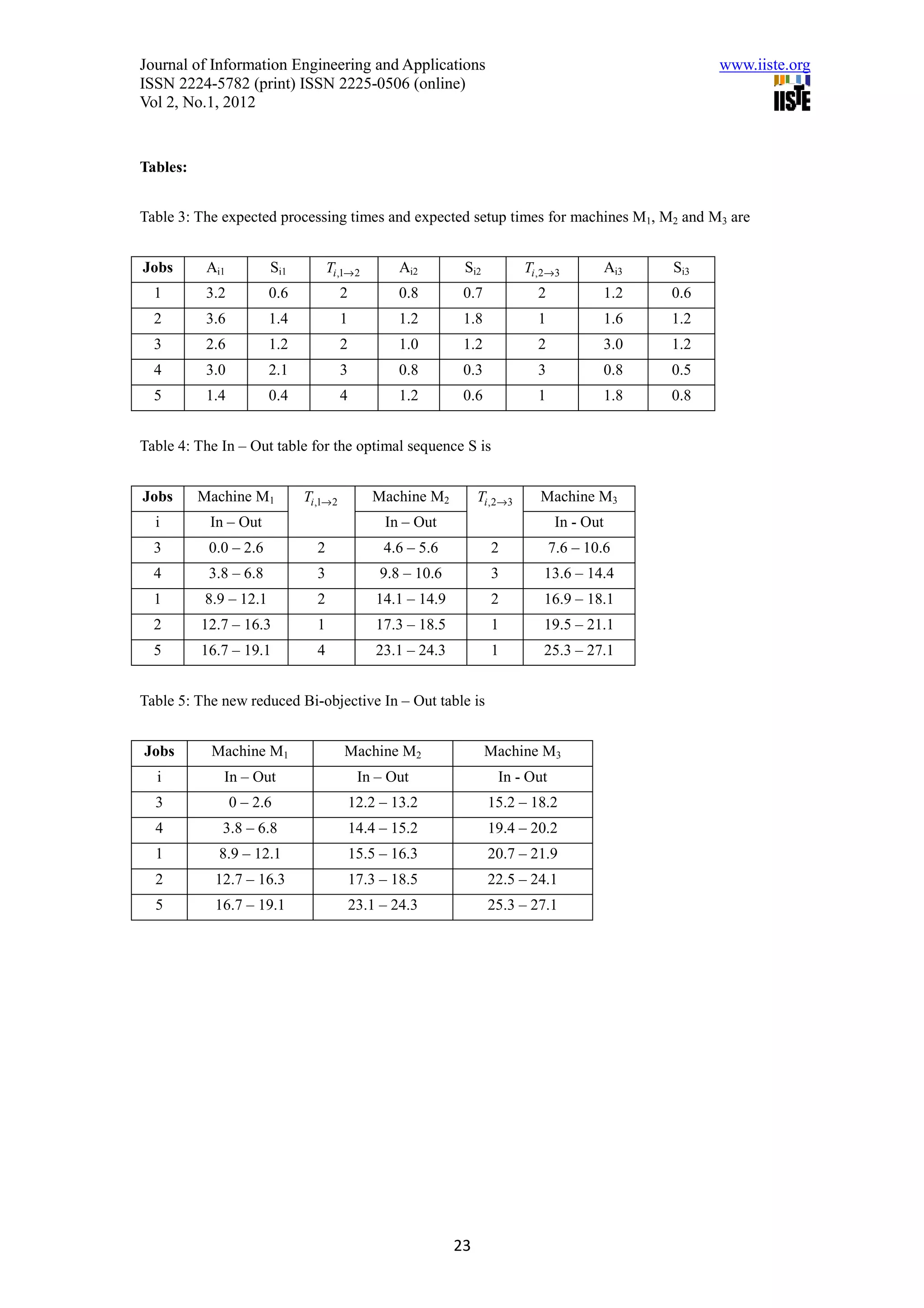This document summarizes a research paper about scheduling jobs in a three machine flow shop to minimize rental costs and completion time. The paper considers processing times, setup times, transportation times between machines, and job block criteria (priority of some jobs). It presents notation to define the problem, discusses a rental policy where machines are rented as needed. It provides theorems and proofs that showing that starting the second and third machines at certain times does not increase completion time. The paper concludes by formulating the scheduling problem and presenting an algorithm to determine machine rental times to minimize total rental cost without increasing completion time.
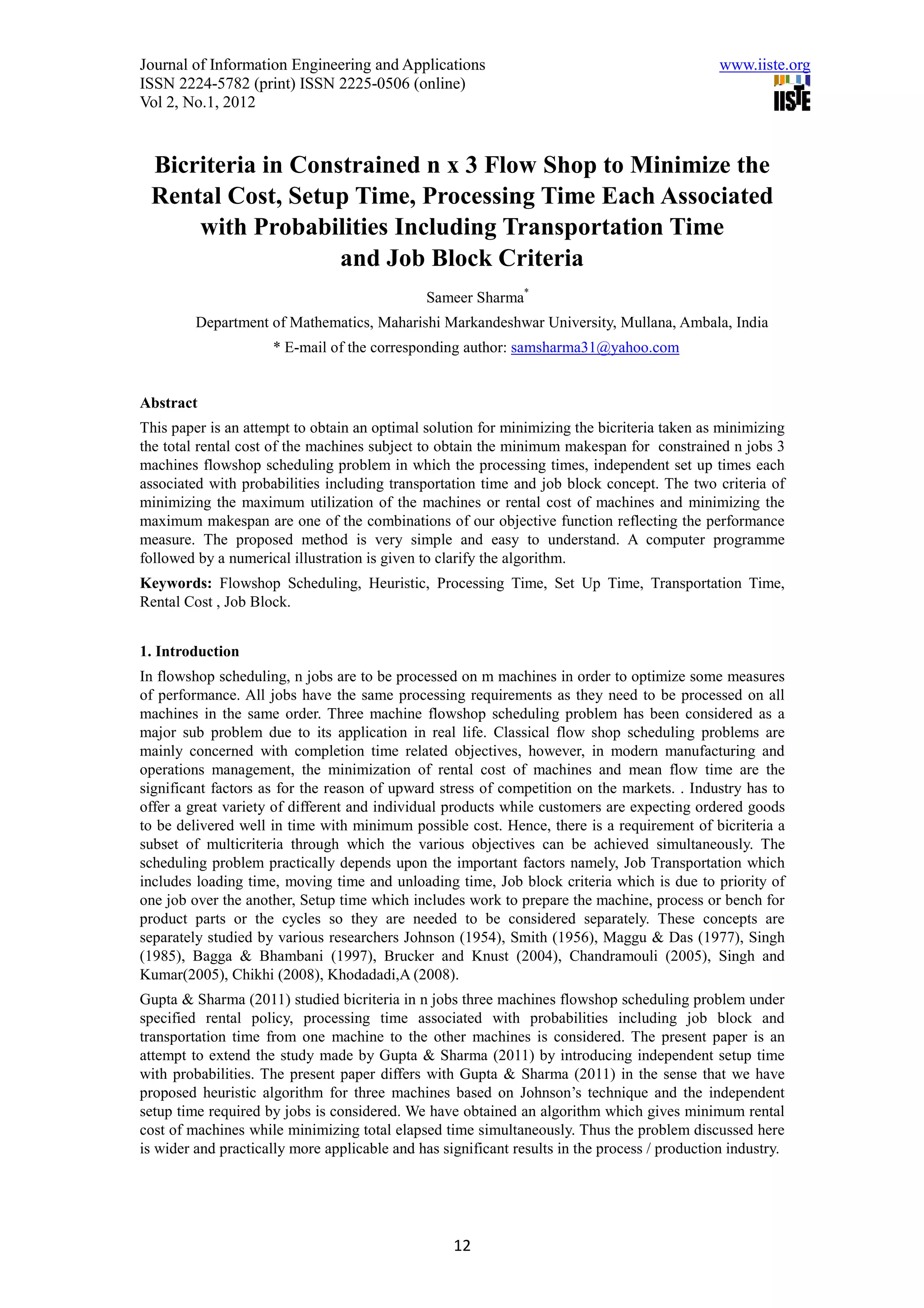
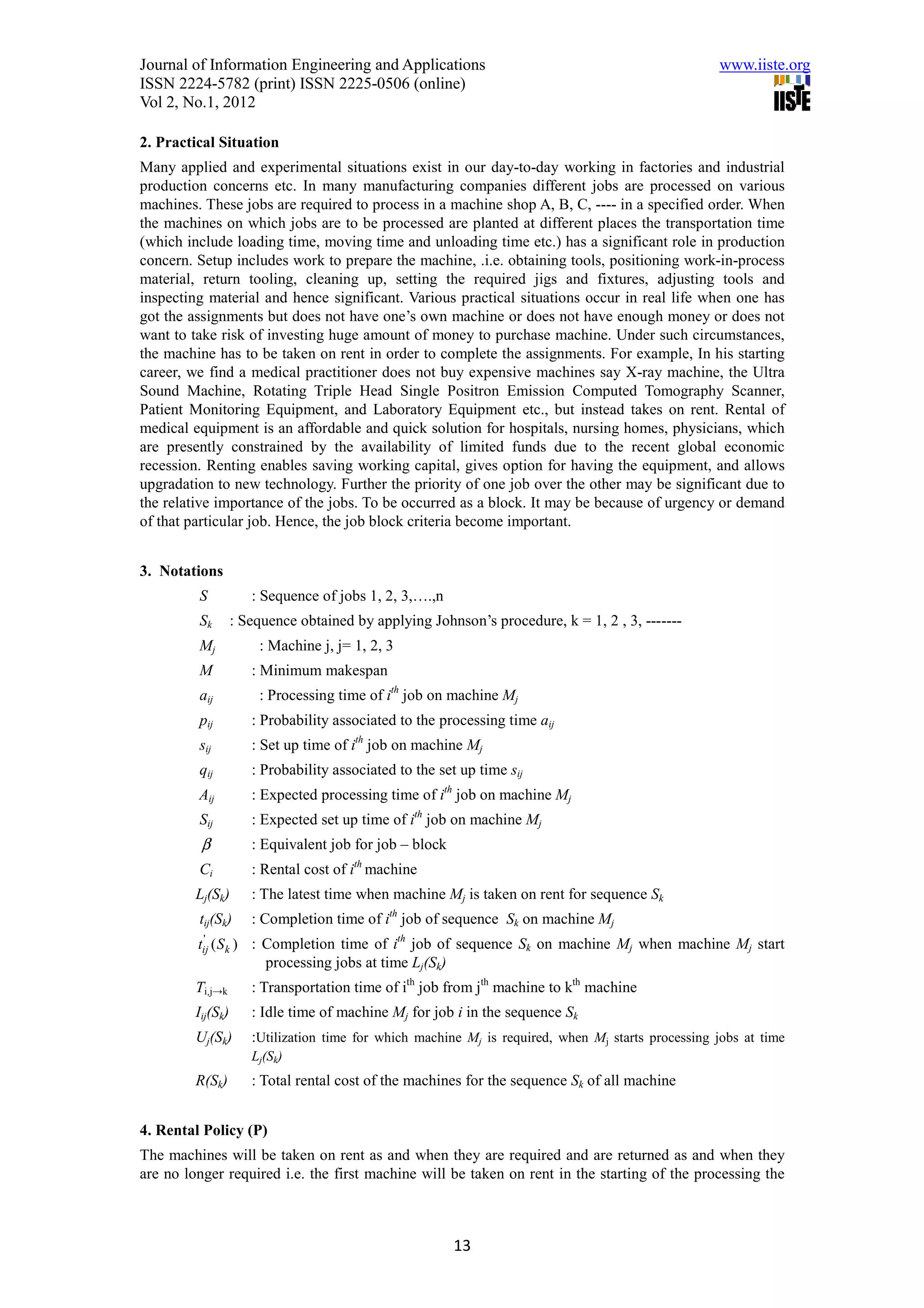
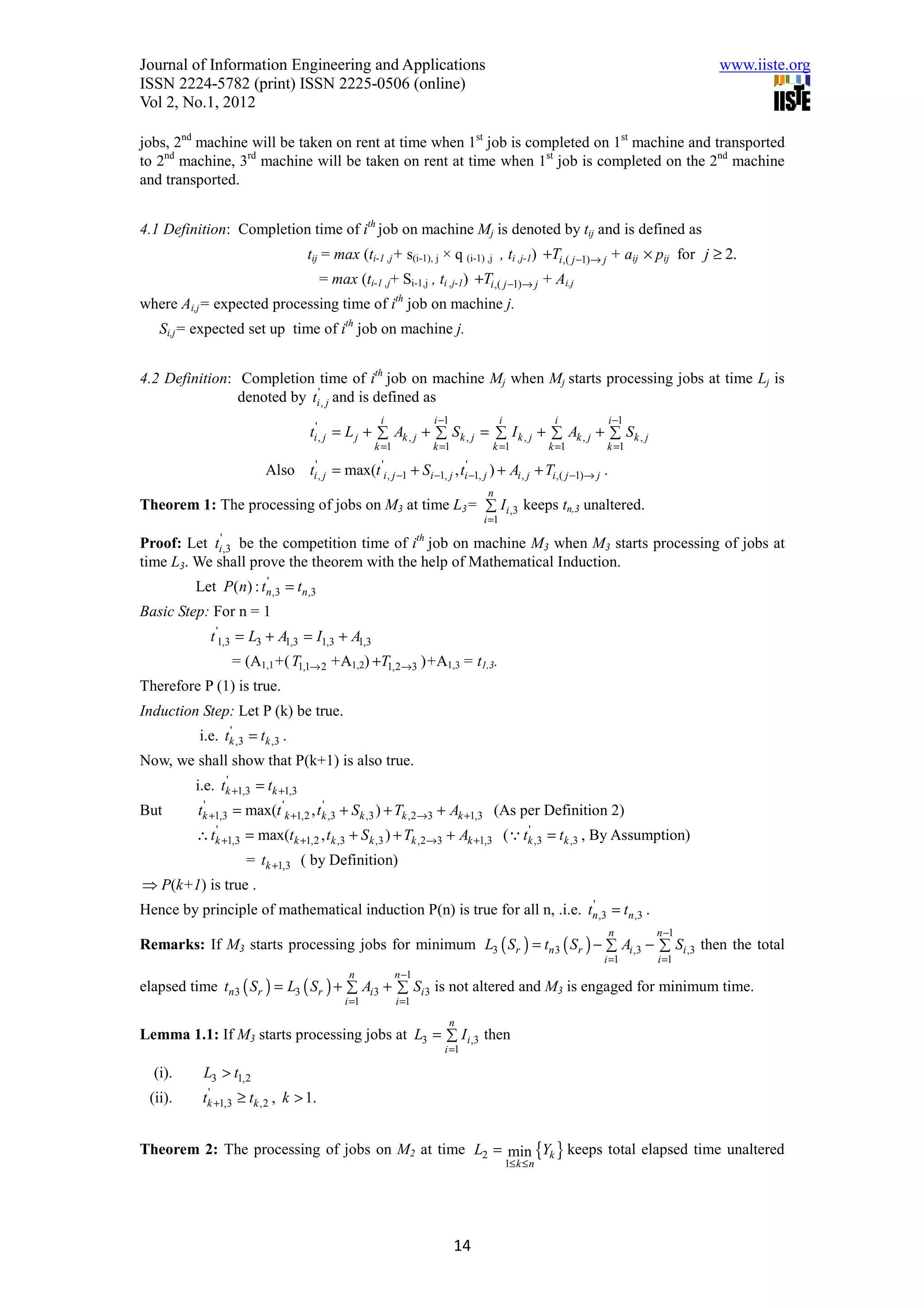
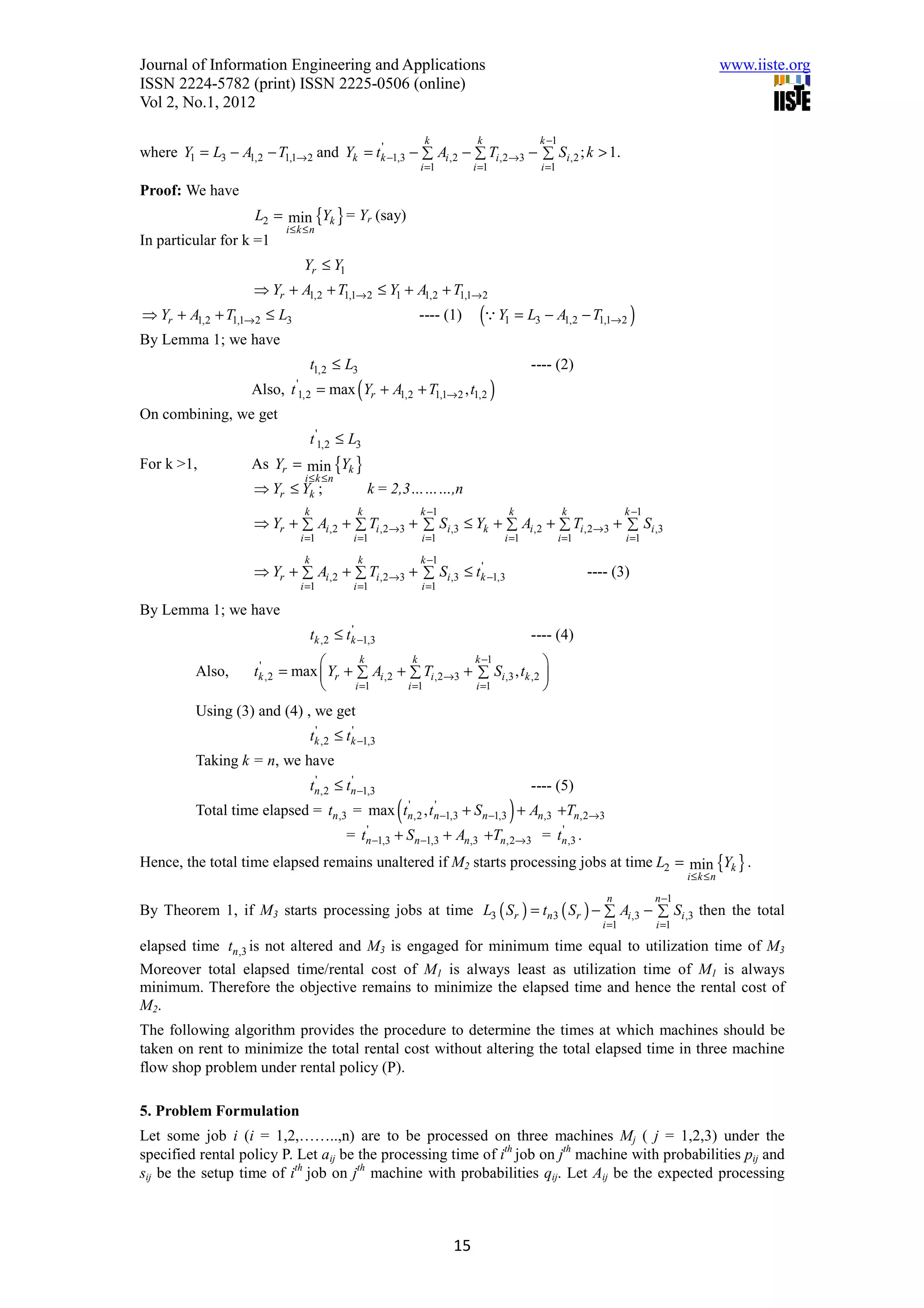

![Journal of Information Engineering and Applications www.iiste.org
ISSN 2224-5782 (print) ISSN 2225-0506 (online)
Vol 2, No.1, 2012
IV. L2 ( Sk ) = min Yq ( Sk )
1≤ q ≤ n
{ }
V. U 2 ( Sk ) = tn 2 ( Sk ) − L2 ( Sk ), U 3 ( Sk ) = tn3 ( Sk ) − L3 ( Sk ) .
Step 10: Find min {U 2 ( Sk )} ; k = 1, 2,..........., r
Let it be for the sequence Sp, and then sequence Sp will be the optimal sequence.
Step 11: Compute total rental cost of all the three machines for sequence Sp as:
R ( S p ) = tn1 ( S p ) × C1 + U 2 ( S p ) × C2 + U 3 ( S p ) × C3
8. Programme
#include<iostream.h>
#include<stdio.h>
#include<conio.h>
#include<process.h>
int n,j;
float a1[16],b1[16],c1[16],g[16],h[16],T12[16],T23[16],s11[16],s22[16],s33[16];
float macha[16],machb[16],machc[16];float cost_a,cost_b,cost_c,cost;int f=1;
int group[2];//variables to store two job blocks
float minval,minv,maxv1[16],maxv2[16];float gbeta=0.0,hbeta=0.0;
void main()
{
clrscr();
int a[16],b[16],c[16],j[16],s1[16],s2[16],s3[16];float p[16],q[16],r[16],u[16],v[16],w[16];
cout<<"How many Jobs (<=15) : ";cin>>n;
if(n<1||n>15)
{cout<<endl<<"Wrong input, No. of jobs should be less than 15..n Exitting";getch();exit(0);}
for(int i=1;i<=n;i++)
{j[i]=i;
cout<<"nEnter the processing time ,setup time and their probability of "<<i<<" job for machine A and
Transportation time from Machine A to B : ";cin>>a[i]>>p[i]>>s1[i]>>u[i]>>T12[i];
cout<<"nEnter the processing time ,set up time and their probability of "<<i<<" job for machine B and
Transportation time from Machine B to C : ";cin>>b[i]>>q[i]>>s2[i]>>v[i]>>T23[i];
cout<<"nEnter the processing timesetup time and their probability of "<<i<<"job for machine C: ";
cin>>c[i]>>r[i]>>s3[i]>>w[i];}
for(i=1;i<=n;i++)
{//Calculate the expected processing times of the jobs for the machines:
a1[i] = a[i]*p[i];b1[i] = b[i]*q[i];c1[i] = c[i]*r[i];s11[i]= s1[i]*u[i];s22[i]= s2[i]*v[i];s33[i]=
s3[i]*w[i];}
cout<<"nEnter the rental cost of Machine M1:";cin>>cost_a;
cout<<"nEnter the rental cost of Machine M2:";cin>>cost_b;
cout<<"nEnter the rental cost of Machine M3:";cin>>cost_c;
cout<<endl<<"Expected processing and setup time of machine A, B and C: n";
for(i=1;i<=n;i++)
{cout<<j[i]<<"t"<<a1[i]<<"t"<<s11[i]<<"t"<<b1[i]<<"t"<<s22[i]<<"t"<<c1[i]<<"t"<<s33[i]<<"t"
;
cout<<endl;}
//Function for two ficticious machine G and H//Finding smallest in a1
float mina1;mina1=a1[1]+T12[1]-s22[1];
17](https://image.slidesharecdn.com/bicriteriainconstrainednx3flowshoptominimizetherentalcostsetuptimeprocessingtime-120126063947-phpapp01/75/Bicriteria-in-constrained-n-x-3-flow-shop-to-minimize-the-rental-cost-setup-time-processing-time-6-2048.jpg)
![Journal of Information Engineering and Applications www.iiste.org
ISSN 2224-5782 (print) ISSN 2225-0506 (online)
Vol 2, No.1, 2012
for(i=2;i<n;i++)
{if(a1[i]+T12[i]-s22[i]<mina1)mina1=a1[i]+T12[i]-s22[i];}
//For finding largest in b1
float maxb1;maxb1=b1[1]+T23[1]-s11[1];
for(i=2;i<n;i++)
{if(b1[i]+T23[i]-s11[i]>maxb1)maxb1=b1[i]+T23[i]-s11[i];}
float maxb2;maxb2=b1[1]+T23[1]-s33[1];
for(i=2;i<n;i++)
{if(b1[i]+T23[i]-s33[i]>maxb2)maxb2=b1[i]+T23[i]-s33[i];}
//Finding smallest in c1
float minc1;minc1=c1[1]+T23[1]-s22[1];
for(i=2;i<n;i++)
{if(c1[i]+T23[i]-s22[1]<minc1)minc1=c1[i]+T23[i]-s22[1];}
float maxs;
if(mina1>=maxb1||minc1>=maxb2)
{for(i=1;i<=n;i++)
{if(s11[i]<s22[i])
{maxs=s22[i];}
else {maxs=s11[i];}
g[i]= a1[i]+b1[i]+T12[i]+maxs; h[i]=b1[i]+c1[i]+T23[i]-s33[i];}}
else {cout<<"n data is not in Standard Form...nExitting";getch();exit(0);}
cout<<endl<<"Expected processing time for two fictious machines G and H: n";
for(i=1;i<=n;i++)
{cout<<endl;cout<<j[i]<<"t"<<g[i]<<"t"<<h[i]; cout<<endl; }
cout<<"nEnter the two job blocks(two numbers from 1 to "<<n<<"):"; cin>>group[0]>>group[1];
//calculate G_Beta and H_Beta
if(g[group[1]]<h[group[0]])
{minv=g[group[1]];}
else {minv=h[group[0]];}
gbeta=g[group[0]]+g[group[1]]-minv;hbeta=h[group[0]]+h[group[1]]-minv;
cout<<endl<<endl<<"G_Beta="<<gbeta;cout<<endl<<"H_Beta="<<hbeta;
int j1[16];float g1[16],h1[16];
for(i=1;i<=n;i++)
{if(j[i]==group[0]||j[i]==group[1])
{f--;}
else {j1[f]=j[i];}f++;}j1[n-1]=17;
for(i=1;i<=n-2;i++)
{g1[i]=g[j1[i]];h1[i]=h[j1[i]];}
g1[n-1]=gbeta;h1[n-1]=hbeta;
cout<<endl<<endl<<"displaying original scheduling table"<<endl;
for(i=1;i<=n-1;i++)
{cout<<j1[i]<<"t"<<g1[i]<<"t"<<h1[i]<<endl;}
float mingh[16];char ch[16];
for(i=1;i<=n-1;i++)
{if(g1[i]<h1[i])
{mingh[i]=g1[i];ch[i]='g'; }
else {mingh[i]=h1[i];ch[i]='h'; }}
for(i=1;i<=n-1;i++)
{for(int j=1;j<=n-1;j++)
18](https://image.slidesharecdn.com/bicriteriainconstrainednx3flowshoptominimizetherentalcostsetuptimeprocessingtime-120126063947-phpapp01/75/Bicriteria-in-constrained-n-x-3-flow-shop-to-minimize-the-rental-cost-setup-time-processing-time-7-2048.jpg)
![Journal of Information Engineering and Applications www.iiste.org
ISSN 2224-5782 (print) ISSN 2225-0506 (online)
Vol 2, No.1, 2012
if(mingh[i]<mingh[j])
{float temp=mingh[i]; int temp1=j1[i]; char d=ch[i];mingh[i]=mingh[j]; j1[i]=j1[j];
ch[i]=ch[j];
mingh[j]=temp; j1[j]=temp1; ch[j]=d;} }
// calculate beta scheduling
float sbeta[16];int t=1,s=0;
for(i=1;i<=n-1;i++)
{if(ch[i]=='h')
{ sbeta[(n-s-1)]=j1[i]; s++;}
else if(ch[i]=='g')
{sbeta[t]=j1[i];t++;}}
int arr1[16], m=1;
cout<<endl<<endl<<"Job Scheduling:"<<"t";
for(i=1;i<=n-1;i++)
{if(sbeta[i]==17)
{ arr1[m]=group[0];arr1[m+1]=group[1];cout<<group[0]<<" "<<group[1]<<"
";m=m+2;continue;}
else {cout<<sbeta[i]<<" ";arr1[m]=sbeta[i];m++;}}
//calculating total computation sequence
float time=0.0;macha[1]=time+a1[arr1[1]];
for(i=2;i<=n;i++)
{macha[i]=macha[i-1]+a1[arr1[i]]+s11[arr1[i-
1]];}machb[1]=macha[1]+b1[arr1[1]]+T12[arr1[1]];
for(i=2;i<=n;i++)
{if((machb[i-1]+s22[arr1[i]])>(macha[i]+T12[arr1[i]]))maxv1[i]=machb[i-1]+s22[arr1[i]];
else maxv1[i]=macha[i]+T12[arr1[i]];machb[i]=maxv1[i]+b1[arr1[i]];}
machc[1]=machb[1]+c1[arr1[1]]+T23[arr1[1]];
for(i=2;i<=n;i++)
{if((machc[i-1]+s33[arr1[i-1]])>(machb[i]+T23[arr1[i]]))maxv2[i]=machc[i-1]+s33[arr1[i-
1]];
else maxv2[i]=machb[i]+T23[arr1[i]];machc[i]=maxv2[i]+c1[arr1[i]];}
//displaying solution
cout<<"nnnnnttt #####THE SOLUTION##### ";
cout<<"nnt***************************************************************";
cout<<"nnnt Optimal Sequence is : ";
for(i=1;i<=n;i++)
{cout<<" "<<arr1[i];}
cout<<endl<<endl<<"In-Out Table is:"<<endl<<endl;
cout<<"Jobs"<<"t"<<"Machine M1"<<"t"<<"t"<<"Machine M2" <<"t"<<"t"<<"Machine
M3"<<endl;
cout<<arr1[1]<<"t"<<time<<"--"<<macha[1]<<" t"<<"t"<<macha[1]+T12[arr1[1]]<<"--
"<<machb[1]<<" t"<<"t"<<machb[1]+T23[arr1[1]]<<"--"<<machc[1]<<endl;
for(i=2;i<=n;i++)
{cout<<arr1[i]<<"t"<<macha[i-1]+s11[arr1[i]]<<"--"<<macha[i]<<" "<<"t"<<maxv1[i]<<"--
"<<machb[i]<<" "<<"t"<<maxv2[i]<<"--"<<machc[i]<<endl;}
cout<<"nnnTotal Elapsed Time (T) = "<<machc[n];float L3,Y[16],min,u2,u3;
float sum1=0.0,sum2=0.0,sum3=0.0;
for(i=1;i<=n;i++)
{sum1=sum1+a1[i];sum2=sum2+b1[i];sum3=sum3+c1[i]; }float sum_1;
for(i=1;i<=n;i++)
{sum_1=0.0,s33[0]=0.0;
19](https://image.slidesharecdn.com/bicriteriainconstrainednx3flowshoptominimizetherentalcostsetuptimeprocessingtime-120126063947-phpapp01/75/Bicriteria-in-constrained-n-x-3-flow-shop-to-minimize-the-rental-cost-setup-time-processing-time-8-2048.jpg)
![Journal of Information Engineering and Applications www.iiste.org
ISSN 2224-5782 (print) ISSN 2225-0506 (online)
Vol 2, No.1, 2012
for(int d=0;d<=n-1;d++)
{sum_1=sum_1+s33[arr1[d]];}}L3=machc[n]-sum3-sum_1;
cout<<"nnLatest Time When Machine M3 is Taken on Rent:"<<L3;
cout<<"nnTotal Completion Time of Jobs on Machine M2:"<<machb[n];
Y[1]=L3-b1[arr1[1]]-T12[arr1[1]];cout<<"nntY[1]t="<<Y[1];float sum_2,sum_3;
for(i=2;i<=n;i++)
{sum_2=0.0,sum_3=0.0;for(int j=1;j<=i-1;j++)
{sum_3=sum_3+c1[arr1[j]]+T12[arr1[j]]+s33[arr1[j-1]];}
for(int k=1;k<=i;k++)
{sum_2=sum_2+b1[arr1[k]]+T23[arr1[k]]+s22[arr1[k-1]];}
Y[i]=L3+sum_3-sum_2;cout<<"nntY["<<i<<"]t="<<Y[i];}
min=Y[1];
for(i=2;i<n;i++)
{if(Y[i]<min)min=Y[i];}
cout<<"nnMinimum of Y[i]="<<min;u2=machb[n]-min;u3=machc[n]-L3;
cout<<"nn Utiliztaion time of machine M1 = "<<macha[n];cout<<"nnUtilization Time of Machine
M2="<<u2;
cout<<"nn Utiliztion time of machine M3 =
"<<u3;cost=(macha[n]*cost_a)+(u2*cost_b)+(u3*cost_c);
cout<<"nnThe Minimum Possible Rental Cost is="<<cost;
cout<<"nnt***************************************************************";
getch();}
7. Numerical Illustration
Consider 5 jobs, 3 machine flow shop problem with processing time , setup time associated with their
respective probabilities and transportation time as given in table and jobs 2 and 5 are processed as a
group job (2, 5). The rental cost per unit time for machines M1, M2 and M3 are 6 units, 7 units and 8
units respectively, under the rental policy P.
Jobs Machine M1 Machine M2 Machine M3
Ti ,1→ 2 Ti ,2→3
i ai1 pi1 si1 qi1 ai2 pi2 si2 qi2 ai3 pi3 si3 qi3
1 16 0.2 6 0.1 2 4 0.2 7 0.1 2 12 0.1 3 0.2
2 12 0.3 7 0.2 1 6 0.2 6 0.3 1 8 0.2 4 0.3
3 13 0.2 4 0.3 2 5 0.2 3 0.4 2 15 0.2 6 0.2
4 15 0.2 7 0.3 3 4 0.2 3 0.1 3 4 0.2 5 0.1
5 14 0.1 4 0.1 4 6 0.2 6 0.1 1 6 0.3 4 0.2
Table - 2
Our objective is to obtain an optimal schedule for above said problem to minimize the total production
time / total elapsed time subject to minimization of the total rental cost of the machines.
Solution: As per Step 1; The expected processing times and expected setup times for machines M1, M2
and M3 are as shown in table 3.
Using steps 2, 3, 4, 5 and 6 and Johnson’s method, the optimal sequence is
S = 3 – 4 – 1 – β , .i.e. S = 3 – 4 – 1 – 2 – 5
As per Step 7: The In – Out table for the optimal sequence S is as shown in table 4.
Total elapsed time tn3(S) = 27.1 units
n n −1
As per Step 8: L3 ( S ) = t n 3 ( S ) − ∑ Ai ,3 − ∑ S i ,3 ( S ) = 27.1 – 8.4 – 3.5 = 15.2 units
i =1 i =1
20](https://image.slidesharecdn.com/bicriteriainconstrainednx3flowshoptominimizetherentalcostsetuptimeprocessingtime-120126063947-phpapp01/75/Bicriteria-in-constrained-n-x-3-flow-shop-to-minimize-the-rental-cost-setup-time-processing-time-9-2048.jpg)
![Journal of Information Engineering and Applications www.iiste.org
ISSN 2224-5782 (print) ISSN 2225-0506 (online)
Vol 2, No.1, 2012
As per Step 9: For sequence S, we have
tn,1 ( S ) = 19.1 , tn ,2 ( s ) = 24.3 , tn,3 ( s ) = 27.1
Y1 = 15.2 − 1.0 − 2 = 12.2, Y2 = 15.2 − 8 + 5 = 12.2, Y3 = 15.2 − 11.1 + 10 = 14.1
Y4 = 15.2 − 14 + 13.7 = 14.9, Y5 = 15.2 − 18 + 16.9 = 14.1
L2 ( S ) = Min {Yk } = 12.2,U 2 ( S ) = tn 2 ( S ) − L2 ( S ) = 24.3 − 12.2 = 12.1
U 3 ( S ) = tn,3 ( S ) − L3 ( S ) = 27.1 − 15.2 = 11.9.
The new reduced Bi-objective In – Out table is as shown in table 5.
The latest possible time at which machine M2 should be taken on rent = L2(S) = 12.2 units.
Also, utilization time of machine M2 = U2(S) = 12.1 units.
Total Minimum rental cost of machines = R ( S p ) = tn1 ( S p ) × C1 + U 2 ( S p ) × C2 + U 3 ( S p ) × C3
= 19.1 × 6 + 12.1 × 7 +11.9 = 294.5 units.
References
Bagga, P.C. & Ambika Bhambani (1997), “Bicriteria in flow shop scheduling problem”, Journal of
Combinatorics, Information and System Sciences, 22, 63-83.
Brucker and Knust, S. (2004), “Complexity results for flow-shop and open-shop scheduling problems
with transportation delays”, Annals of Operational Research,129, 81-106
Chakarvarthy K. and Rajendrah, C. (1999), “A heuristic for scheduling in a flow shop with bicriteria of
makespan and maximum tardiness minimization”, Production Planning & Control, 10 (7), 707-714.
Chandramouli, A.B. [2005], “Heuristic Approach for n-job,3-machine flow shop scheduling problem
involving transportation time, breakdown interval and weights of jobs”, Mathematical and
Computational Applications, 10(2) , 301-305.
Chikhi, N. (2008), “Two machine flow-shop with transportation time”, Thesis of Magister, Faculty of
Mathematics,USTHB University ,Algiers.
Gupta, D., Singh, T.P. and R. Kumar (2007), “Bicriteria in scheduling under specified rental policy,
processing time associated with probabilities including job block concept”, Proceedings of VIII Annual
Conference of Indian Society of Information Theory and Application (ISITA), 22-28.
Gupta, D.,Sharma, S., Seema and Shefali (2011), “Bicriteria in n × 2 flow shop scheduling under
specified rental policy ,processing time and setup time each associated with probabilities including job-
block”, Industrial Engineering Letters, 1(1), 1-12.
Gupta, D., Sharma, S. & Gulati, N. (2011), “n × 3 flow shop production schedule, processing time, set
up time, each associated with probabilities along with jobs in a string of disjoint job-block”, Accepted
in Antarctica Journal of Mathematics, Vol. 8, 2011.
Gupta, D.,Sharma, S., Seema and Shefali (2011), “Bicriteria in n × 3 flow shop scheduling under
specified rental policy ,processing time associated with probabilities including transportation time and
job-block criteria”, Mathematical Theory and Modeling, 1(1), 7-18.
Johnson S.M. (1954), “Optimal two and three stage production schedule with set up times included”,
Naval Research Logistics Quart., 1(1), 61-68.
Khodadadi, A. (2008), “Development of a new heuristic for three machines flow-shop scheduling
problem with transportation time of jobs”, World Applied Sciences Journal , 5(5), 598-601.
Maggu P.L. and Das G. (1977), “Equivalent jobs for job block in job scheduling”, Opsearch, 14(4),
277-281.
Narian,L. & Bagga, P.C. (1998), “Minimizing hiring cost of machines in n × 3flow shop problem”,
Proceedings of XXXI Annual ORSI Convention and International Conference on Operation Research
and Industry, Agra[India].
Narain, L. (2006), “Special models in flow shop sequencing problem”, Ph.D. Thesis, University of
Delhi, Delhi.
21](https://image.slidesharecdn.com/bicriteriainconstrainednx3flowshoptominimizetherentalcostsetuptimeprocessingtime-120126063947-phpapp01/75/Bicriteria-in-constrained-n-x-3-flow-shop-to-minimize-the-rental-cost-setup-time-processing-time-10-2048.jpg)

